#museum bellerive
Photo

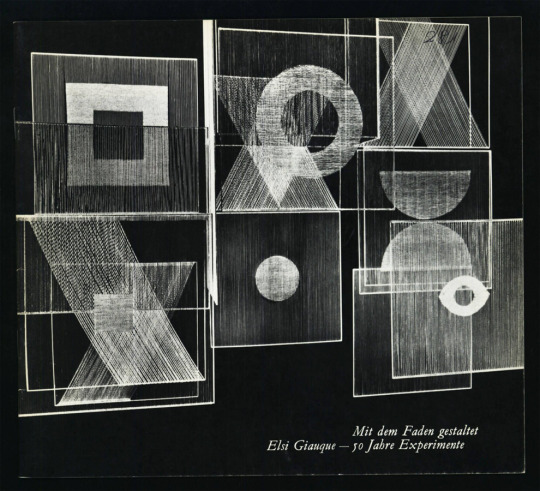
Mit dem Faden gestaltet. Elsi Giauque – 50 Jahre Experimente, Museum Bellerive Zürich, 1971 [Exhibition: March 26 – May 9, 1971] [Museum für Gestaltung Zürich]
#graphic design#design#textile#geometry#pattern#exhibition#catalogue#catalog#cover#elsi giauque#rené gauch#marlen perez gruber#museum bellerive#museum für gestaltung zürich#kunstgewerbemuseums zürich#1970s
87 notes
·
View notes
Text
“Abakan Red” by Magdalena Abakanowicz
Artist: Magdalena Abakanowicz (Poland) Title: Abakan Red Year: 1969 Collection of: the Museum Bellerive, Zurich USEFUL LINKS: Magdalena Abakanowicz …“Abakan Red” by Magdalena Abakanowicz

View On WordPress
1 note
·
View note
Photo

Lingerie - Eine Unterwelt
Museum Bellerive Zürich 1998
3 notes
·
View notes
Text
Cities are Not Biological Deserts
by Nicole Heller
Cities are increasingly important in organizing the experience of people and their interactions with nature. In 1950 there were 2.5 billion people on Earth and 30% lived in cities. Today, there are 7.5 billion people and 55% live in cities. By 2050, there will be an estimated 9.5 billion and 68% will live in cities.
Generally, cities are not good places for other critters to live. The abundance of pavement, buildings, traffic, pollution, pesticides, herbicides, and other hazards make cities really hard places for plants and animals to survive and breed. From a conservation science perspective, cities have long been considered dead spaces, or biological deserts. But more recently researchers are paying more attention to nature in cities. One reason for their interest involves people’s need for nature. Study after study confirms the basic biophilia hypothesis, that people want to associate with nature; they are happier and healthier when they are near plants and animals in their daily lives.

Berlin is recognized as a city that works for people and biodiversity due to its high percentage of green space, variety of habitats, and thoughtful regional planning. Photo by Filipe Varela on Unsplash.
Cities have also drawn the attention of researchers because of some really exciting things are happening within their limits, such as growing populations of peregrine falcons , sightings of rare birds using cities parks during annual migrations, and even discoveries of new species not previously known to science. While cities are overall negative for biodiversity, recent research findings raise important questions: Can human cities be good for non-humans too? Can urban wildlife include a broader spectrum of creatures beyond the common city-adapted species like European sparrows, pigeons, and black rats? What about species special or unique to the regions in which cities are located? How can we make cities work for biodiversity?
A few years ago I posed these questions along with colleagues from the Resilient Landscape program at the San Francisco Estuary Institute. We wanted to learn if there were general lessons that could be distilled from recent and ongoing research projects about what kinds of species can benefit from cities and if so how might city planners utilize this information to prioritize actions that would help cities contribute positively to the resilience of regional biodiversity, or at least do more to diminish the negative impacts.
Earlier this year, some of our findings were published open source in the journal Bioscience, The Biological Deserts Fallacy: Cities in Their Landscapes Contribute More than We Think to Regional Biodiversity, by Erica N Spotswood, Erin E Beller, Robin Grossinger, J Letitia Grenier, Nicole E Heller, Myla F J Aronson.
The study, which includes citations from dozens of regional research projects around the world, identifies five pathways by which cities can help regional biodiversity. “Cities can benefit some species by releasing them from threats in the larger landscape, increasing regional habitat heterogeneity, acting as migratory stopovers, enhancing regional genetic diversity and providing selective forces for species to adapt to future conditions under climate change (e.g., a phenomenon we are calling preadapting species to climate change), and enabling and bolstering public engagement and stewardship.”
Each of these pathways is described in greater detail in the study. Four categories of species commonly utilize urban habitat, with varying degrees of success, and the study explores examples of how specific species in specific places demonstrate these five pathways.

Overall, the role of cities in supporting landscape-scale biodiversity is an understudied area of research. As cities continue to grow in number and size, human populations rise, and climate change continues, paying attention to the experience of other critters, and how we can make space for them to survive and thrive in anthropogenic habitats, will be more important than ever. This research identifies opportunities to reconcile cities with biodiversity. Opportunities exist to learn more about the unique resources that cities can provide, which specific types of species can take advantage of these resources, and how this information can be incorporated into city plans for parks and green spaces. The San Francisco Estuary Institute has begun this applied work in their report Making Nature’s City, which presents a science-based framework for increasing biodiversity in cities.
What excites me are possibilities if we really try. For the most part cities have been developed with little or no concern for biodiversity. Often people think that humans and nature just can’t coexist. What if city planners and conservation professionals start applying these lessons from ecology more broadly and work together with citizens to deliberately steward biodiversity in cities? How abundant and rich with diverse life could cities become? How happy would that make humans? I wonder. And I am hopeful.
If you are interested in urban nature, you can help to measure its diversity by participating in the museum’s upcoming City Nature Challenge. You never know what you may find in our city. Our combined observations, coupled with the museum’s collections and records, will provide important benchmarks to help track how local species are doing as the region keeps growing and changing in the 21st century.
Full Article Citation
The Biological Deserts Fallacy: Cities in Their Landscapes Contribute More than We Think to Regional Biodiversity By ERICA N. SPOTSWOOD , ERIN E. BELLER, ROBIN GROSSINGER, J. LETITIA GRENIER, NICOLE E. HELLER, AND MYLA F. J. ARONSON
BioScience, Volume 71, Issue 2, February 2021, Pages 148–160, https://doi.org/10.1093/biosci/biaa155
Nicole Heller is Curator of Anthropocene Studies at the Carnegie Museum of Natural History. Museum employees are encouraged to blog about their unique experiences working at the museum.
#Carnegie Museum of Natural History#Anthropocene#Biodiversity#Urban nature#City Nature Challenge#City Life#Urban living
108 notes
·
View notes
Text
my long ass review for S32E03 Now Museum, Now You Don’t
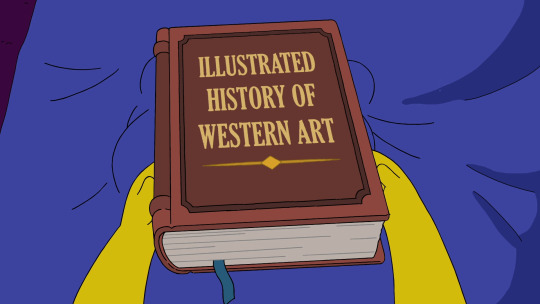
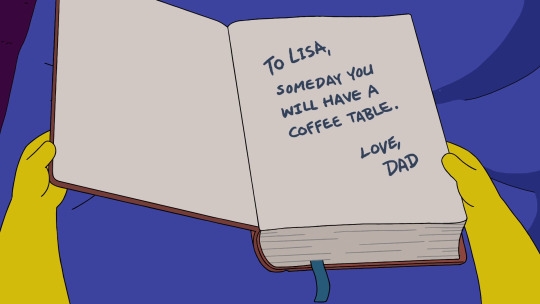
warning: LONG because i rambled about history more than i thought i would
id been looking forward to this one because i like art history, especially after seeing how they tried their best to stick to historical accuracy in the previous episode I, Carumbus. this time however….they didnt try that hard. i dont know why i thought theyd go through that sort of trouble again LMAO
but its okay, i dont really expect the simpsons to be the paragon of historical accuracy or anything. especially in anthology episodes told through a particular character's lens (in this case, lisa, whos already feverish so whatever)
first i just wanna say that this is, i guess, less of a review and more of an accidental list of history fun facts. so im just gonna get my general thoughts out of the way first.
the episode was fun! to me at least haha. i mean it got me to think and do a lot of research on my own so that must count for something. besides a couple of really weird ones, the jokes were good. anthology episodes tend to be….not that good but i thought this one was one of the better ones so far. idk.
anyway on to lisanardo da vinky
its the renaissance! jesus christ the italian accents in the beginning of this segment were annoying as hell but i also feel like that was the joke lmao. ill be real i kind of tuned out for a second there when grampa started rambling so idk what he said.
i told myself i wouldnt get nitpicky with historical accuracy if the jokes were funny (final edit: so that was a lie) but this meh bit with the pizza guys and mascots was really not worth ignoring the fact that its impossible for italy to have any tomato-based food in the 15th century (tomatoes were brought to europe from the americas in the 16th century, and pizza as we know it today—flatbread, cheese, tomato—originated in the late 18th century)

oh this next part was kind of legit tho. lisanardo, like the real leonardo, became andrea del verrochio's apprentice at his workshop. i loved this next bit:

"Whoever paints the sweetest cherub will have the honor of having MY name signed on their work. That's what great artists do!"

SO YEAH as it turns out, lisanardo painted the sweetest cherubs. the painting here is called The Baptism of Christ, and the real leonardo assisted verrochio in finishing it. specifically, he painted the cherubs in the corner.


this causes verrochio to quit and go someplace with less talented people: a music school (yes, verrochio did quit painting after getting owned by young leo and his mad angel painting skills. he never did anything with music tho, he was more of a sculptor)
alongside lisanardo, in mr largo-verrochio's workshop we have barticelli (botticelli bart), dolphatello (donatello dolph), ralphael (raphael...ralph) and mediocrito (no one that i know of. sorry milhouse) (and kearney i guess but they dont refer to him by name). botticelli and donatello are said to have also been apprentices at verrochio's workshop, but raphael came a couple of decades later so he couldnt have been there. and donatello was too old so that claim is a bit questionable. but anyway
it IS true that leonardo's peers envied him, to the point where he was anonymously and purposefully accused of being gay (a major crime punishable by death in 15th century florence) while he was still working at verrochio's workshop
we are then treated by what im pretty sure is the fourth time the show has used 'at seventeen' by janis ian, this time sung by a dejected lisanardo (man they really do keep making yeardley sing these days huh) who only wishes to be appreciated and not envied.
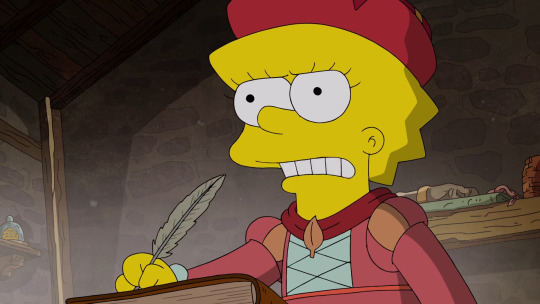
"I'll show them all! I'll show them all in a secret diary that no one will decipher for 400 years!"
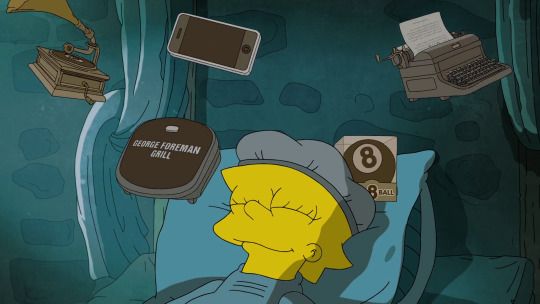
some of lisanardo's future inventions. who wouldve known
so after barticelli, for some reason (revenge??? or something?? what was his plan here idgi) steals lisanardo's diaries full of blueprints of her inventions and takes them to mr burns who i have to assume is pope alexander VI here, they decide to use her inventions for war.
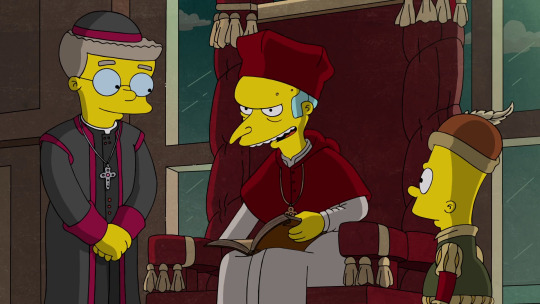
"With these, we can kill the most evil people in the world!! ....Slightly different Christians."
leo actually did this of his own accord. im surprised this is what they decided to do with lisanardo instead of talking about leo's love of nature and vegetarianism (not a single mention of that in this episode? come on...) then again, trying to do good only to end up indirectly making things worse is a very standard lisa storyline. i guess they didnt want to miss the chance to have evil pope burns (very fitting, especially for that era since they were all about money and controlling the people)
so lisanardo decides to leave for france, unlike the real leonardo who was more or less persuaded by his ultimate fanboy king francis I to move to france.
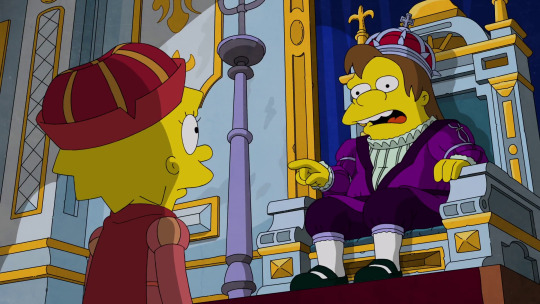
"Lisanardo, I have many questions. Why are you hitting yourself? A nerd says 'what'? And how is it possible that I am rubber and you are glue? Et cetera, et cetera."
that line may seem a little random, like hes just nelson saying nelson things (and i mean, obviously he is) but the real francis also "had an unquenchable thirst for learning, and Leonardo was the world’s best source of experimental knowledge. He could teach the king about almost any subject there was to know, from how the eye works to why the moon shines." so yeah, he did have many questions and lisanardo, finally being appreciated for her intellect, was happy to answer them all. its very interesting how lisa assigned this role to nelson in her retelling of da vinci’s life :^)
and so she lived the rest of her days in france, nat king cole's 'mona lisa' plays because duh, and they make a da vinci code reference because duh. and the segment ends. and not a single time did they show the actual mona lisa painting. the fuck?

(ngl i was fully expecting bart to say 'leonardo da vinky' for a second here)
so this next segment is about french impressionist painters, most likely the batignolles group, a name adopted by the early representatives of impressionism. its much more vague than the lisanardo segment since no one here is referred to by name (except moe, more on him in a sec) but i dont feel like it really matters in this case. bart is prrrrooobably claude monet but its hard to say, this segment is kind of a mish-mash of a lot of things.
also i gotta say i really liked how lisa introduced the story to bart with an 'if you hate the formal study of art' and not 'if you hate art' because thats exactly my headcanon. i LOVE the concept of artist bart and whenever its referenced it just makes perfect sense to me.
anyway the segment opens in 1863 at the école des beaux-arts (back then it was actually known as the académie des beaux-arts), preserver of traditional french art styles. skinner reviews his students’ paintings one by one. praises the plain, unimaginative paintings depicting your typical european countryside landscapes. very run-of-the-mill (haha get it...cuz theres….a windmill) (although the real académie didnt approve of such basic stuff, they wanted artists to draw epic historical and mythological scenes)
then he gets to barts painting and he gives him an F- because the painting made him think.

(the paintings in this scene arent real famous paintings as far as i know but they are inspired by real paintings enough to get the point across)
in comes barney dressed as bacchus as a model for the students to sketch, which i just loved:
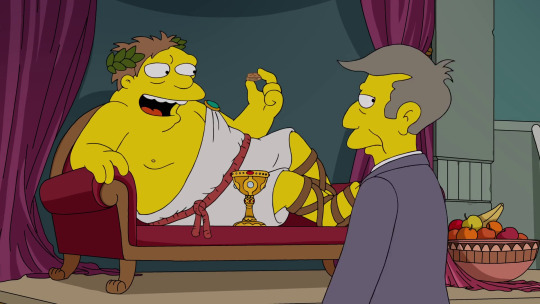
barney: “You prefer robe open or robe off?”
skinner: “Just cover your privates with this walnut shell.”
barney: “Whoa!!! So roomy!”
skinner gasps in horror at bart’s sketch, which “looks nothing like him” and bart explains that “it shouldn’t; we’re making the art that we feel because we can’t compete with a camera.” damn, you go bart. take that, realism. draw what you feel!!

(also no, you didnt need to hold still for 17 hours for a daguerreotype. 30 min tops.)
nelson haw-haw of the week: FOIE-gras!
so here they are at the moulin rouge (“enjoy it before baz luhrmann ruins it” hey shut up. i love that movie), which wouldnt be built for another 26 years, but it is the most widely known gathering place for bohemians in the public consciousness so i can understand why they went with the moulin. nelson delivers this anachronistic line:

“This époque keeps getting beller and beller!”
which alludes to la belle époque, the golden age of france usually dated from 1880 to 1914. made me snort so ill let that slide
and heres moe! as henri de toulouse-lautrec, who was actually born a year after the year this segment is set in. yo moe szyslak he was just 1
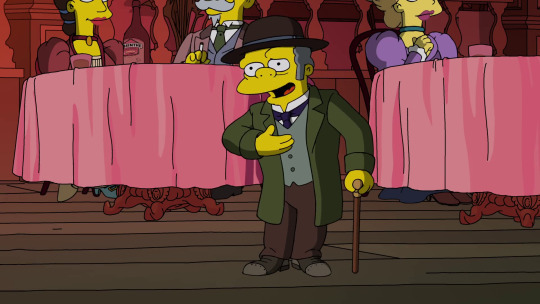
toulouse-moetrec introduces himself as the chronicler of the demimonde (not an actual job). an iconic figure associated with the moulin rouge (largely due to his affinity for alcohol and prostitutes), toulouse-lautrec was also a painter, having illustrated a series of posters for the moulin himself. he simply had to be in this segment, anachronisms be damned, just because they decided to include the moulin. cant have one without the other.
and yes he did have a walking cane where he kept his liquor.

i love how everyone drinks absinthe in this place. theyre bohemians what else would they drink
toulouse-moetrec points out that barts paintings are the greatest thing hes ever seen (and hes seen like five things!) and that hes a genius. milhouse realizes that they should stop doing what the teacher says and use their own minds to instead...start doing what bart says lmao. to the easels!
next we have skinner hyping up chalmers about the art his students made for the salon de paris, an art exhibition that the emperor of france will attend. he assures him that none of these paintings will encourage debate, provoke thought or be out of place at a dentist’s office. when they unveil the art, theyre both SHOCKED at how scandalous the paintings actually are.



this reaction was kind of accurate. impressionism was severely rejected at the salon de paris, due to paintings not looking finished enough to them, they thought they were ugly and vulgar for depicting nudity in a contemporary setting (historical and mythological nudity was fine). these impressionist paintings were sent to the salon de refusés, which is. yeah. the place where they sent the rejects. the salon de refusés does not make an appearance but this scene makes a reference to it when the artists get expelled from the royal salon. also:
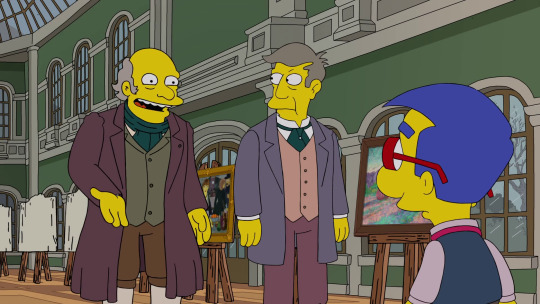
“What about our student loans?”
“Oh they’ll be refunded. We are not barbarians, I mean, come on.”
(god if only)
so the painters are down because they want the emperor to actually see their paintings. toulouse-moetrec pipes in once again with an idea.
“There is one thing the emperor loves more than anything.”
“France?”
“No, he hates France.”
apparently the emperor really loves cheese, which makes sense since its napoleon III (who loved cheese) and homer (who loves cheese.) so the painters roll into the salon inside a giant wheel of cheese (obviously.) as lenny said, “Eh, you know French cheese. Very runny.” napoleon III chases after the wheel into a room, where the wheel falls apart after getting chomped on by the emperor. now that they got his attention, the painters proudly show the emperor their impressionist art, which he couldnt be more indifferent about because he just wants to eat his cheese dammit, and he awards them with the royal medallion just to kind of get them out of his way. skinner immediately starts kissing ass (as he does) until marge’s like ‘hey wait a minute. you expelled these students from the royal salon’ and an executioner immediately starts ominously measuring skinners neck.
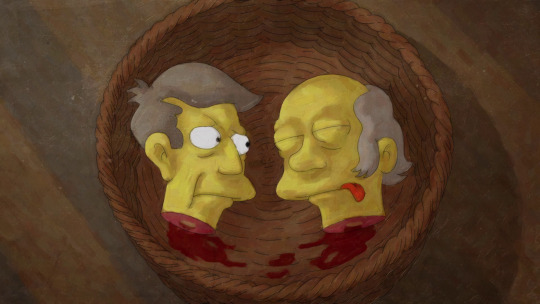
“Uh, sir...is your tongue sticking out because you’re dead or because you’re mad at me?”
and thats the end of that lmao (gore in this episode, gore in the last episode, and next week we’re getting gore too cuz its THOH, what the hell is goin on)
we get a short intermission with maggie, who wants a story for her too! lisa tells her that renaissance artists loved to put babies in their paintings, especially baby angels.
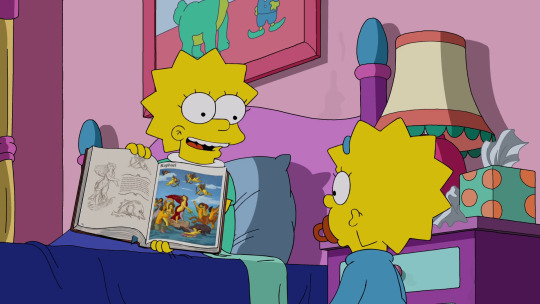
here she is showing her The Triumph Of Galatea by raphael:
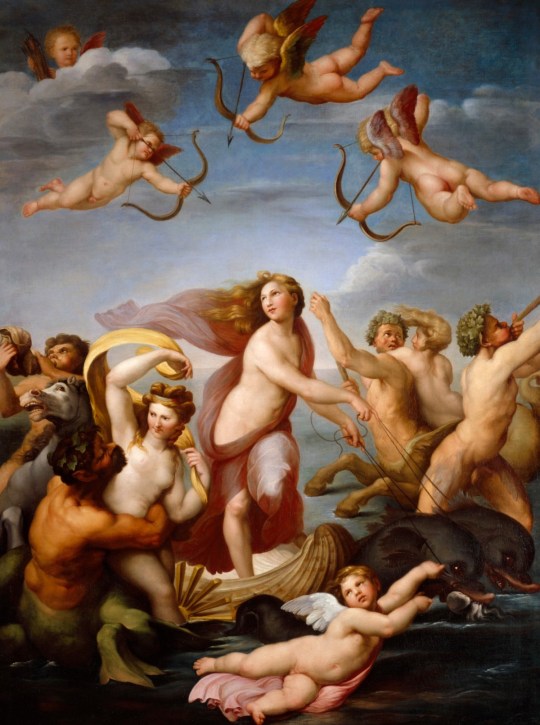
King David Playing The Harp by peter paul reubens:
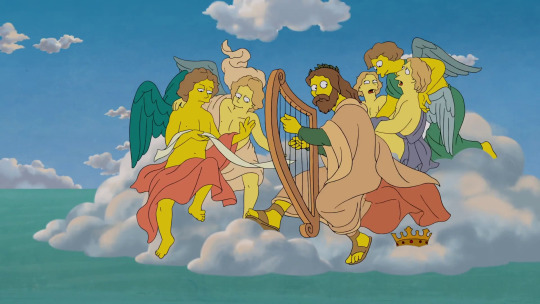

and a very simplified version of pretty much any depiction of hell by hyeronimus bosch lmao:
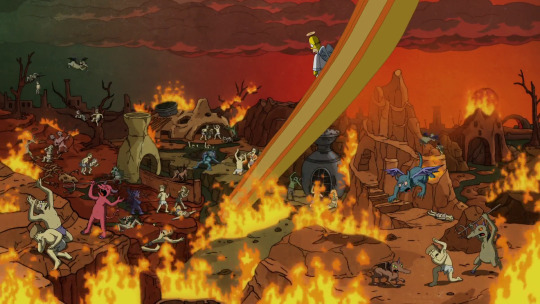
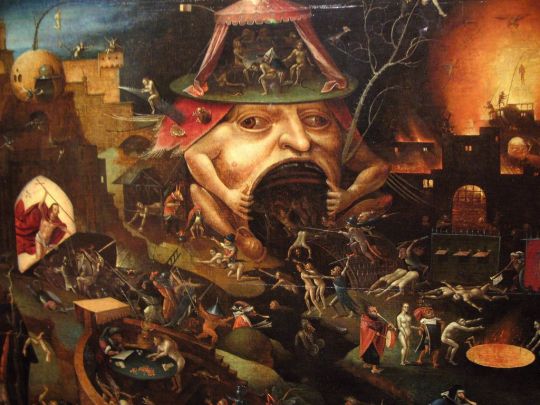
not much else to say about this one, really. but i really liked that sky!
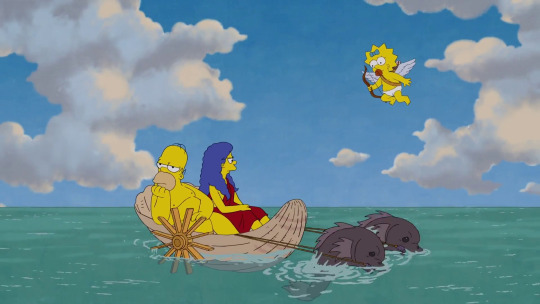
the last segment is about frida kahlo and diego rivera. or as bart puts it ‘the one about a fat guy whos wife is too good for him.’ i was REALLY looking forward to this one because i love frida and i thought itd be a cool opportunity for animators to go bonkers and do really cool shit with her art as inspiration…..but the segment is not about frida, its about diego and his selling out to capitalism. and its also yet another story with homer and marge drama. no funky cool animation here. sigh i guess i’ll take it
the story begins in 1929 at la casa azul, frida’s home (now museum dedicated to her life and work.) frida and diego are getting married. this courtyard definitely did not look this way yet back in 1929. also theres something very cringy yet funny about lovejoy saying spanish words the way he does, i honestly cant decide how i feel about that one

the writers know theyre being cringy with their gringoness so they go along with it.
moe: “Spanish for ‘best wishes’!”
mel: “Spanish for ‘congratulations’!”
bumblebee man: “Spanish for ‘muy bueno’!”
OH YEAH BUMBLEBEE MAN this is his new voice actor, eric lopez! hes not mexican but its still great to finally have a latino actor voicing a latino character and hes very excited to be part of the show so i hope to hear more of him!! im rooting for him
el barto/zorro makes an appearance which i am very confused about. he has jack shit to do with frida and diego and mexico in the 20s-30s. el zorro was set in the spanish california of the early 19th century. their use of the original theme song makes me think they just wanted to flex their disney privileges tbh

lets not talk about that that whole scene was bad
anyway diego announces he and frida are going to new york, without even asking her first. frida is obviously pissed.
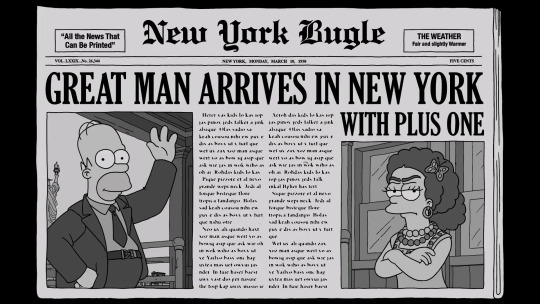
“Don’t worry, as a woman, you’ll be treated with much more respect in America.”
so in new york, diego is having a bit of a business meeting with mr burns as one of the members of the rockefellers, who is commissioning him to draw a mural for the rockefeller center. its kinda funny how he refers to him and frida as socialists even though they were very much communists lmao its okay you can say it. ok so far, but then frida says ‘yes, we hate the capitalists! right now, a young socialist is being born who will take them down! mr. bernie sanders. i hope hes quick about it’ and that was a simple enough joke and couldve been left at that but then its immediately followed by this weird as fuck family guy-esque cutaway gag to bernie as a baby:
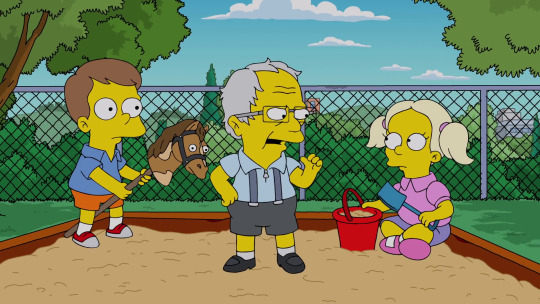
“Getting a cootie shot should not cost your lunch money. And if you don’t listen to me, listen to the Bernie Babies! What? Everybody’s got goons.” *larger babies start beating up this other baby* “I disavow that, and welcome it.”
this confused me so much that i had to ask one of my american friends to help me understand, but even she was like ‘uhhh yeah thats a weird joke,’ especially now that hes been out of the race for months (then again these episodes take almost a year to produce. i guess they couldnt be bothered to replace it with something more relevant.) whatever that was weird and confusing and unfunny moving on
frida is pretty irked that diego is going through with this deal. after all, it goes against everything they believe in. im not sure how the real frida felt about diego doing the mural, but she did feel a bit of rage during her visit to the united states, especially the obvious disparity between rich and poor. she hated having to interact with capitalists and found americans very boring. in this segment, frida seems to be acting more like the american communist party, which diego got kicked out of for accepting commissions from wealthy patrons. in any case, frida is pretty upset about this whole thing.
and finally we get the first and only kind of surreal frida moment. kinda. maybe. its more cartoonish than anything but im desperate ok


interesting how they felt like they had to add a “don’t smoke” in big letters after showing patty and selma flying away on their giant cigarettes. i wonder if this is something theyre making them do now? i remember hearing something about them toning down patty and selma’s smoking
diego comes home to frida, drunk as hell, followed by the marx brothers. i cant believe they didnt make a marxism joke come on it was RIGHT THERE. THE MARX BROTHERS. KARL MARX. COME ON

frida paints her feelings.
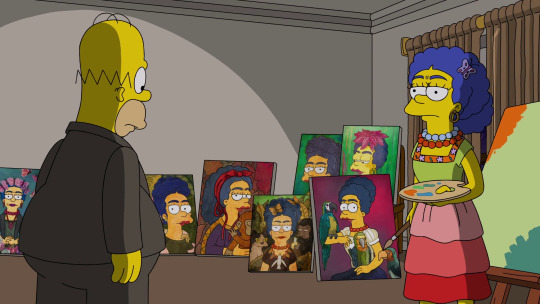
this makes diego realize that frida is a genius and he is not half the artist she is. he proclaims he will now show his awe of her by sleeping with other women, starting “an hour ago.” to which frida replies, “and i will start sleeping with other women, starting two hours ago.” yes this was pretty much their relationship. though im just wondering how the hell did diego not know frida was this kind of artist until now? i know homers an idiot but jeez. art was how frida and diego met, diego knew from the get-go that frida was an incredible artist. i guess the fame got to his head or something. again, homer just being stupid.
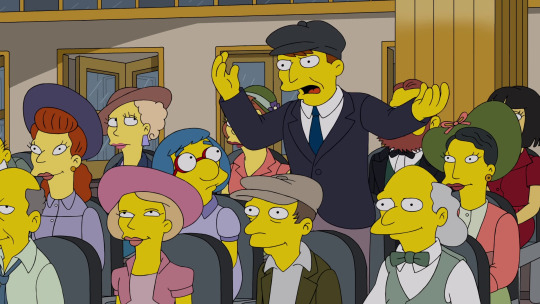
“well enough already, while the art is still deco, okay?”
its time for the mural diego painted, Man At The Crossroads, to be unveiled:
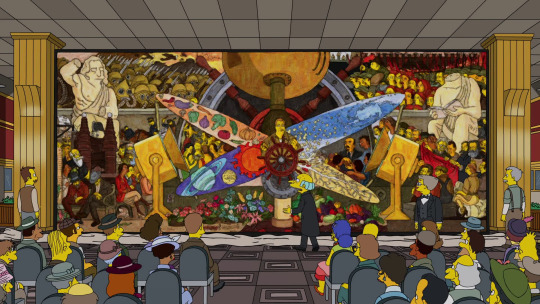
rockefeller examines it. good and great so far, and then...uh oh
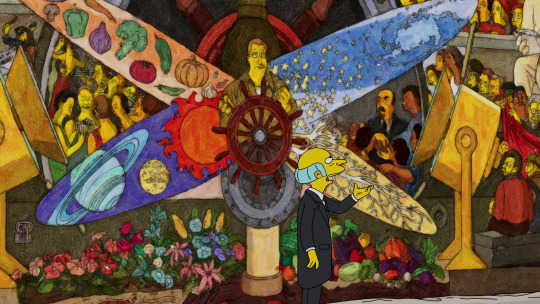
“Who’s that fellow…? With the beard, and the bolshevik smile…”
“That’s the founder of Soviet Russia, Lenin!”

“B-b-but he’s a communist!”
“Oh he just attended a couple of meetings.”
rockefeller will not have this communist in the temple to capitalism that is the rockefeller center, so he orders diego to paint over it. diego stands his ground and refuses. despite rockefeller’s threats, diego says that theres only one person he wants to be proud of him no matter what and in true homer & marge fashion, frida is touched by this. they happily leave the rockefeller center.
now, the real story of Man At The Crossroads and the rockefeller center was actually not that different. as soon as the rockefellers found out diego had snuck in a portrait of lenin into the mural, they ordered him to paint over it, to which he refused. diego even offered to include abraham lincoln and even american abolitionists in the mural as a compromise, but the rockefellers simply did not want any references to communism whatsoever. they did not complain about the hammer and sickle, though. yes, they did know diego was a communist and hired him anyway. what did they expect? lmao. diego said:
"Rather than mutilate the conception [of the mural], I shall prefer the physical destruction of the conception in its entirety, but preserving, at least, its integrity."
so they decided to destroy the mural before it was even finished and they never talked to each other again.

diego then repainted the mural at the palacio de bellas artes back in mexico, this time known as Man, Controller of the Universe. this new version included even more communist leaders and a depiction of john d. rockefeller jr. drinking at a nightclub, right underneath a depiction of syphilis bacteria. cue nelson haw-haw:
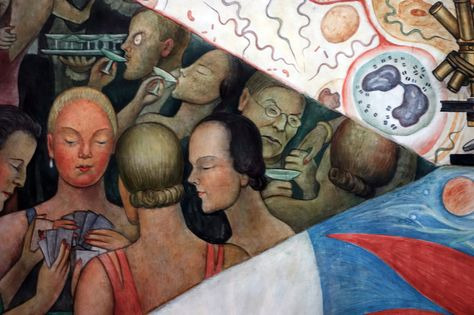
this was the version they used in the episode also, since the original was, well, never finished and also destroyed. only a black and white photograph of it exists, taken by diego before it was destroyed so he could remake it.
right so, homer!diego then pulls a Barthood and finishes the episode with a large mural summarizing the entire episode. he says some rick and morty thing i didnt get because i dont watch the show idk idc

the end
ALRIGHT NOW ITS TIME FOR THE STORY OF VINCENT VAN MOE
#if you read all of this bless you#the imageless gdocs version of this is 8 pages long#hope you...enjoy?!?! these art history fun facts?!?!#dont let me do something like this again but also let me know if i should do something like this again#i was really only motivated to do this because im already passionate about the subject so idk if i could do it otherwise#anyway. this took me all day yesterday because the power kept going out#but im finally done#bye
54 notes
·
View notes
Photo

"Kiki Smith feels like such a necessary artist at this moment. Coming into her own creatively in New York City during the AIDS epidemic, her work encompasses the personal and the bodily, and the collective and the social. The strikingly proportioned figure in Annunciation feels alone in a personal, spiritual moment. The work seems to contain so many stories, and as Kiki recently told me, 'I am just trying to make something that feels like what I know inside.'"
Posted by Catherine Morris
Kiki Smith (American, born Germany, 1954). Annunciation, 2008. Cast aluminum, wood. Brooklyn Museum, Purchased with funds given by John and Barbara Vogelstein, Alan and Leslie Beller, Constance and Henry Christensen III, Nikola Duravcevic and Dana Ben-Ari, Stephanie and Tim Ingrassia, Leslie and David Puth, Elizabeth A. Sackler, John S. Tamagni, Barbara and Bill Wynne and Designated Purchase Fund , 2011.78a-b. © Kiki Smith, courtesy of Pace Gallery (Photo: Photography by Kerry Ryan McFate, courtesy The Pace Gallery)
#artforthesociallydistanced#brooklyn museum#museums#coronavirus#social distancing#bkmcontemporary#kiki smith#sculpture#art#brooklyn
28 notes
·
View notes
Photo

Have you registered for our free Hanukkah story series? Join us each night of Hanukkah for a story and craft perfect for some quality family time.
Celebrate the Jewish holiday of Hannukah virtually with the Jewish Museum of Maryland, the Center for Jewish Education, PJ Library, the JCC, and other community partners.
Come together each night and listen to stories read by local families, enjoy interactive holiday crafts, and light the menorah candles. A special Hanukkah-related theme will inspire each night’s activities.
This program series is FREE and best suited for children age 10 and under.
Thursday, December 10th at 5 pm
Friday, December 11th at 4pm
Saturday, December 12th at 6pm
Sunday, December 13th at 5pm
Monday, December 14th at 5 pm
Tuesday, December 15th at 5 pm
Wednesday, December 16th at 5 pm
Thursday, December 17th at 5 pm
Join the CJE Library, Sonia Kozlovsky and her grandchildren for The Magic Dreidels.
Join PJ Library for a special Shabbat-themed night of Hanukkah.
Join the CJE Library for a night of Havdalah and Hanukkah Music.
Join JMM and Octavia Shulman for a night about the history of Hanukkah, including Maccabee: The Story of Hanukkah and a shield-making craft.
Join the JCC, Megan Beller and her family for a Hanukkah night about courage, including Herschel and the Hanukkah Goblins.
Join the CJE Library, JMM, and the Tenenholz family for a night dedicated to the Lights of Hanukkah, including Nathan Blows Out the Hanukkah Candle.
Join the JCC for a Hanukah story and craft.
Join the CJE Library for a night of Hanukkah games!
3 notes
·
View notes
Text
3/6/2020 Chicago
I got to hang out with a whole bunch of awesome people before this show, both people I knew and ones I just met that day. It almost made it worth the freezing temperatures to meet them all. Once we got in to the much warmer venue, I got a spot to the left of the keyboard, with folks to talk to on both sides.
Fresh outdid himself in the fashion department at this show. As he was setting up, he proudly displayed jagged-striped pink-and-green neon socks, a yellow sweatshirt with Simba printed all over it, and a headband with a print I didn’t catch all the details of, but included the word “Krap!” and bull horns.
Note: I am shortening the recap for the first set, since it was a copy of the one from the night before, except that they didn’t play the forward version of Sapphire Bullets. This show didn’t have much banter in the first set regardless, but I’ll share what there was. The second set recap will be the regular length
During the first block of songs, Dan had to switch to his backup electric briefly, which sounded louder than the other, but switched back by the next song. Danny had a band-aid with him when they went onstage. He unwrapped it and put it on his thumb during the first few songs, then spent the rest of the set rewrapping it as it kept peeling off.
After the first block of songs, Flans asked Linnell how it was going. Linnell told him to hold on because “I have to check.” After a pause, he decided “I think it’s going pretty good.”
Flans said he had a good day and that he had taken an afternoon nap. He had also worked on some of the songs he had messed up the day before because “There is no off-switch on this okay button.”
Linnell replied that “Buttons with switches on them are tricky,” and then changed the subject, introducing us all to his new keyboard stand. “I did get a new keyboard stand and I can’t stop talking about it.”
Flans told him that talking a lot about the keyboard stand was okay because of “how much you have to listen to us talk about guitar amps.”
Linnell gave us some more details on the keyboard stand. According to him, the stand has wells in the front because it is based on his old keyboard stand, which was designed by Brian Dewan “who’s greatest wish was to design a school desk.” “I keep my math homework over there, and over here I carved the Aerosmith logo” He then told us that the new stand has a drawer, which the old one didn’t. Linnell wanted to open the drawer to show us, but it wasn’t facing anyone, so he told Flans that they should post a video of what it looks like online.
When Linnell brought up that Minimum Wage has a whip crack in it on the album, he suggested that the audience could do it here. Flans replied that the audience would have to, since they didn’t finish sound production on the song.
Before Stilloob, Flans called it the “Playing a Song From Flood Backwards Challenge.” While explaining what they would do, he told us that for this part of the show “I don’t want to say there is no audience enjoyment, but the amount of audience enjoyment is finite.” At the next stopping point after the song Flans announced “We are challenging all other They Might Be Giants like bands. WE KNOW who they are,” to complete the ‘challenge’. During the next song, Lucky Ball and Chain, Flans pulled what I presume was the lyric sheet for Stilloob off of his stand, crumpled it up, and threw it upstage behind Curt’s riser.
Flans told the balcony that they couldn’t rock out too much, and that the venue last night had been “like playing in a coliseum.”
Later, Flans decided the show was going too fast, and he had to slow it down. He told us to get out our phones, demanding “What are you? At work?” when we were slow to do so. Then he had the whole band come up to pose for photos. We were told to post the photos and tag them @hodgeman. I wonder if any confused fans actually did.
In between sets, Fresh had to fight with a lady standing a few people to my left, who kept putting her jacket and purse on the carpet for Marty’s electronic drum kit, even after he had asked her to remove them. Saul, making sure the lights for the Quiet Storm were adjusted properly, bent his legs while checking at Linnell’s mic so that he could check how the lights were at Linnell’s height, which was a hilarious necessity I hadn’t considered before.
When the intro music for the second set began, Flans stuck onstage by going around behind the risers for some reason. Once he made it to his mic with his guitar, I realised he didn’t have his glasses on.
Once again, 2082 was the first song of the set, despite the setlist, which had 2018 written instead. Linnell’s mic was off for the first line and a half of the song, so it was a strange start, although the rest of the song was unaffected by it.
Because I was right by the electronic drum kit, the whole Quiet Storm was a bit strange, as the actual sound of the mallets hitting sounded as clear as the electronic sounds those hits generated. It was a bit disorienting at first! I also could see little pieces of fluff falling off of the mallets and floating away as he played.
After 2082, they played Music Jail, which once again blew me away. I realized that a big part of its ability to be so rocking was that the electronic drums allowed Marty to take over a larger part of the song.
Once Music Jail was finished, John Brunette slipped onstage to give Flans his glasses. Flans stepped back to grab them and even way off mic, it was easy to hear his cry of “Oh, thank god” Stepping quickly back to the mic and placing his glasses on his face, he introduced Linnell as on on the keyboards for the next song.
“Nothing makes our short, unsatisfying unplugged set better than electronic drums and a keyboard,” he announced.
“It’s acoustic!” Linnell promised us, “Except for the drums and the keyboard.”
Moving on, Flans introduced the next song. “This song is about what makes New England so special, which might not mean much here.” This led, of course, into Wicked Little Critta, and then they all left us with the Underwater Woman Video once again while the crew cleaned up.
As the song was finishing, they all returned to the stage. Linnell, watching the video as he came on, mouthed along to a few of the words, basically singing along to himself.
Rather than start back into the music right away, Flans came up to the mic and told us all “We talk a lot about healthcare in the band. Now it's time to talk about some music.” He told us the next song was off of My Murdered Remains “a name no one in our management was happy with” and mentioned that it was not available for streaming.
Linnell chimed in to say that this was a new strategy, calling it an ‘inreach’ program instead of outreach. “If you think you can help,” Flans said to the crowd “We’re okay!” Then they started into The Communists Have the Music.
From there, they played Wearing a Raincoat, and then Damn Good Times, which was their first deviation from the setlist of the night before! I had honestly grown a bit tired of this song in 2018, but clearly all I had needed was some time away, because I was overjoyed to hear it again! Dan was, of course, particularly amazing during this song, and especially smiley during the remainder of the set.
They paused only briefly after DGT to announce that the next song was about a near eastern rock band, then played The Mesopotamians, followed immediately by Spy. Linnell had a different sample this time around, a woman singing “very-very” which I couldn’t place, and he also yelled high and low opposite the band playing. Flans had a bit more luck directing the crowd than he did in Milwaukee, and also engaged in playing his guitar while pressing his mic stand to the strings.
They played Ana Ng, which is always fun live, and then Let Me Tell You About My Operation, with Flans calling out “Paging Doctor Beller!” before that absolutely epic drum part in the instrumental part of the song.
After that run of songs, everyone on stage looked a bit breathless. Linnell must have been feeling it, since he decided they needed to “take this high energy and slow it down by talking about something boring.”
Flans agreed with him and said that the show was going by too fast. “It’s like it’s still the first set. It’s like we still care!”
Linnell, who had just taken a sip from his coffee cup, mentioned that his new keyboard stand had no drink holder but “I guess school desks don’t have drink holders”
“You do have a rearview mirror,” Flans pointed out.
“I do!” He turned it around briefly so that we all could see. “It’s so Marty can keep an eye on me. So he can see if I’m making faces.”
“Marty has ways of keeping an eye on everybody,” Flans added. “Now that it’s the third act of Behind the Music all the secrets everyone already knew can come out.”
Linnell started to respond, then broke off “Danny is pressuring me to start the song, isn’t he?” Danny was waiting attentively, but patiently behind the keyboard. When Linnell asked about him, I looked over and he met my eyes. I smiled at him, and shook my head. He wasn’t pressuring Linnell at all! He smiled back at me, and walked over to stand in front of Marty’s riser. Linnell, meanwhile, had turned to look for Danny asking “Where is he?” Finding Danny’s new spot, Linnell told him “Okay Danny, we can start the song.”
This led into Museum of Idiots. Danny does seem to get a bit nervous about starting this song, which makes sense because it’s him all by himself for the first few measures. I also think that the Johns tend to intentionally go off on tangents before this song just to tease him about it, but that’s only speculation.
Istanbul was very similar to the previous night (which means it was great). I realized that Dan is playing both his acoustic and his electric guitar during the course of this song, which is awesome!
They finished out the set with Theme from Flood, but were back on soon for their first encore. This started out with New York City. Most of the time, their live version of this song starts off with an almost lullaby-esque quality to the first verse, before being kicked up into a super high-energy song from the second verse onward. During this performance though, that transition never happened, meaning that the whole song was performed in that softer tone, with Flans sweetly singing and the gentle xylophone tones on Linnell’s keyboard. It was absolutely beautiful, but perhaps not entirely intentional. I saw some of the guys exchanging ‘wtf’ looks during and after the song, and as soon as the song was over, Linnell told us all he was a bit confused.
They played Doctor Worm next, with Linnell changing the settings on the keyboard for Dan once again. Once it was over, as they were leaving the stage again, Marty smacked his head straight into a mic as he was walking offstage. I guess he wasn’t looking where he was going, but he shook it off and seemed fine.
The second encore started with She’s An Angel, the version that starts with just Linnell singing so wonderfully. They finished out their evening by playing The Guitar, with Curt and Linnell giving us the Future of Sound. During FoS Marty, who was keeping time on his kick drum, had his hands above his head, and was moving them slightly as if he might clap, then jerking them back apart, which was beautifully bizarre. Finishing the Guitar, Flans thanked us all for coming out and they left the stage for the night.
After the show, Marty and Danny were back on to give things out, Danny with a huge pile of stickers that he began passing out right away. After a few moments, he broke off to give out setlists. After giving one to me, he said “Goodnight, sweetie,” and touched my shoulder. I left the venue feeling lighter than air.
14 notes
·
View notes
Link
OKLAHOMA CITY - There's nothing like the stars to draw in tourists and Oklahoma has more than its share of famous faces. In Tishomingo, it's Blake Shelton who has put the small town on the map.
It's not Nashville, but when Blake Shelton is in town, it might as well be.
"We love you Blake," a group of fans screamed on the streets of Tishomingo.
They were among dozens of other fans lining up to see Shelton and fellow country music star Luke Bryan in a benefit concert that was held recently for the Oklahoma Wildlife Conservation Foundation.
"It's cool, I've never been to Tishomingo, so it's pretty cool," said Katrina Beller, a fan from Tulsa.
But the fans came from all over.
"Drove to Boston, flew to Dallas, rented a car and drove here," said Sue Foran, a fan from Connecticut.
She made the trek to Oklahoma just to watch Shelton perform at his new venue, The Doghouse.
"This is literally a dream come true for me to have something like this," said Blake Shelton.
The music hall is an extension of Shelton's already popular restaurant Ole Red.
"I was gone for 11 years but when I finally found that moment that seemed appropriate where I felt like I had my foot in the door in Nashville, I had some songs on the radio, I'm gonna slip back to Oklahoma," said Shelton.
That was in 2006 and since then Shelton has helped draw visitors to his adopted hometown of Tishomingo.
"The amount of traffic that we have has increased probably 70-80 percent compared to before he came," said Tishomingo Mayor Don Keel.
Shelton's presence spurred other businesses downtown and even a new visitors center.
"It's all year, you have thousands of people that come in," said Kelcey Upton, special events manager for the city.
Tishomingo is the capital of the Chickasaw Nation, where visitors can see the historic Chickasaw National Capital building and other museums like Chickasaw Council House and the Chickasaw White House.
(( Link to chickasaw nation https://www.chickasaw.net/ ))
Just outside of town, you can get a taste of the outdoors where the Luther and Vicki Harbert built a one cabin bed and breakfast after retiring from teaching.
"They want peace and quiet, they love to listen to the cattle, they love to hear the birds sing, they can't believe all the stars at night," said Vicki Harbert, Cedar & Stone Bed and Breakfast. (( https://cedarandstonebb.com/ ))
Vicki does the cooking and Luther shows them nature. He takes guests across his nearly 900-acre cattle ranch.
"I never tire of bringing anyone over here and sharing this with them," said Luther Harbert, Cedar & Stone Bed and Breakfast. "It's a good place to just come and disconnect and kick your feet up and enjoy nature."
And while the country music draws them in, it's the beauty of the town that keeps them here a little bit longer.
8 notes
·
View notes
Photo

Johannes Itten, Museum Bellerive Zürich, May 5 – July 29, 1973 [Museum für Gestaltung Zürich]
#graphic design#art#geometry#invitation#invitation card#brochure#johannes itten#museum bellerive#museum für gestaltung zürich#1970s
47 notes
·
View notes
Text
Top Ten Places (That You Might Not Think of) to Visit
The Adriatic Sea, viewed from the city walls of Dubrovnik
In a few days, I will be publishing my annual Top Ten D&O Stories list for 2018. For now, though, I know that everyone is enjoying the holidays, and that right now no one really wants to be reading about insurance or the law. So instead, over the next few days I am going to be publishing a series of alternative Top Ten lists, starting with today’s list of Top Ten Places (That you Might Not Think of) to Visit.
First, a few preliminaries. There are some big obvious places that everybody wants to visit. No one needs me to tell them that, say, London, Paris, Vienna, Madrid, or Rome are great places to visit. So today’s the Top Ten list is a sort of an alternative list. This is a list of places you might not know about but that you really ought to visit. Without any further ado, here is my Top Ten List of Places to Visit, starting with number 10. (Please also see my list of Top Ten Urban Hikes, below)
Seoul, Korea
10. Seoul: At first blush, Seoul might seem to be an odd choice for this list. It is one of the largest cities in the world by population. But despite its size and undeniable prominence I doubt it would make most people’s list of top places to visit. The fact is that Seoul is full of interesting and historical sites, great restaurants and street food, and interesting neighborhoods. And the best of all, there is a massive national park full of mountains and hiking trails right in the city.
The Five Grand Palaces of the Joseon Dynasty are now largely restored and make for interesting exploration. The tree-lined Insadong neighborhood is lively and full of interesting restaurants in the narrow side-alleys serving regional cuisine. The pedestrianized streets in the Myeongdong neighborhood are lined with stores and full of food vendors selling street food from food carts. The Bukhansan National Park, a beautiful area of forested mountains covering over thirty square miles that can be reached by city bus. (See more about the park in the second list, below). Seoul is an unexpectedly interesting place, well worth a visit. (My blog post about Seoul is here.)
The main hall at Gyongbokgung, with Bukhansan looming in the background
Evening in the Insadong neighborhood
Street food in the Myeongdong district
9. Mostar: Mostar is the largest city in the Herzegovina province of Bosnia-Herzegovina. It is also one of the most colorful and interesting places I have ever visited. It sits astride the beautiful, naturally green-tinted Neretva River. The city’s streets and skyline reflect the city’s long history as part of the Ottoman Empire. The main shopping street has the feel of a Turkish bazaar. The river’s eastern shore is lined with mosque minarets.
Minarets over the Naretva River, in Mostar
The street market in Mostar has the feel of a Turkish bazaar
The high point of Mostar is its famous Stari Most (the Old Bridge), which connects the city’s Muslim eastern side to its Catholic Croat west side. The bridge was completed in 1568, under the Ottomans. It is considered by many to be the preeminent piece of Balkan Islamic architecture. It was destroyed during the terrible war that wracked the country in the 1990s. The bridge unites the river’s eastern Muslim side to its Catholic Croat side, although the divisions between the communities unfortunately remain. It has been beautifully restored, though many other traces and remnants of the war remain. Mostar is a fascinating place — there are very few other places where history seems quite so raw and accessible. My blog post about Mostar is here.
The Stari Most, in Mostar
The Stari Most and the Naretva River, Mostar
Hobart, Tasmania
8. Hobart: Located on the Derwent River and nestled beneath Mt. Wellington on the Australian island of Tasmania, Hobart is far, far away, but well worth the journey. Within the city, the Queen’s Domain, a rolling park full of woodlands and fields, includes the last of the island’s original endemic grasslands. A great bicycle path rolls along both sides of the river; the Tasman Bridge connects the city to the communities on the river’s far side. The bike trail on the opposite side goes through bike trails through the riverside communities of Rosny, Bellerive, and Howrah, affording breathtaking views back toward the city and the mountain behind. Hobart is about as far away as you can get but it is a great place to visit. Distant, calm, and beautiful. (My post about Hobart is here.)
The Queen’s Domain, in Hobart
Along the Derwent River, in Hobart
Royal Castle, in Warsaw’s Old Town
7.Warsaw: Warsaw, Poland’s capital city, largely destroyed in WWII, is today a dynamic city full of life. Its historic, atmospheric Old Town has been painstakingly and stunningly restored. Although many remnants of the Soviet era remain, they are slowly being replaced. One of the city’s many unexpected features is that it is full of green space. Nowy Świat, the Royal Route, lined with shops, restaurants and cafés in restored neo-classical buildings, runs through the city’s historic district and connects the royal palaces. Along the way is the Łazienki Krowlewskie (Royal Baths) park, a wooded, 200-acre area that includes the baroque 17th century Palace on the Isle. There are also a number of interesting museums and memorials testifying to city’s terrible 20th century ordeals, including most notably the Warsaw Rising Museum, dedicated to the tragic Warsaw Rising of 1944. (My post about Warsaw is here.)
Nowy Świat, the Royal Route, in Warsaw
The Palace on the Isle in Łazienki Krowlewskie (Royal Baths) park
Oslofjord
6. Oslo: Oslo, Norway’s capital city, is located at the northern end of Oslofjord. The city’s proximity to the mountains means that the Nordmarka recreational area can be reached on the city’s Tunnelbane (metro), affording great views of the fjord. In the city proper, the Det kongelige slott, built in the 19th century and now serving as the home of Norway’s present King Harald V and Queen Sonja, sits on a rise within the city center and looks eastward down Karl Johans gate, the central city’s main thoroughfare, toward the Storting, the Norwegian Parliament building. Along the harbor is the city’s most recognizable landmark, Akershus Festning, a 13th century fortress located on a headland within the harbor at the top of the fjord, and the new distinctive Opera House, built on the city’s harbor in a shape intended to be reminiscent of an ice berg. The views along the harbor are distinctive as well, and, as noted below, there are great places to hike in and around Oslo as well. There are a lot of great places to visit in Scandinavia, but Oslo is a great place to start. My posts about Oslo are here and here.
Det kongelige slott
Oslo Opera House. Note the cranes behind; Oslo is basically one big construction site as the country puts its oil wealth to work
A frozen mist over the Oslo harbor
6. Budapest: Budapest is a big beautiful city full of Old World Europe charm. In his book, The Danube, a Cultural History, Andrew Beattie called Budapest “the loveliest and most elegant city on the Danube.” Budapest, Beattie writes, “takes the Danube to its heart.” In Budapest, the steep hills along the city’s west side “allow an appreciation of just how much the river seems to be cradled by the city.” It is as if the Danube is “flowing, steady and implacable, through a cupped hand.” Buda, on the city’s Western hilly side, and Pest, on the level eastern side, were for most of their history separate cities. The two formerly separate cities are now joined by numerous bridges.
Budapest on the Danube
The two most distinctive features on the Buda side are the historic Castle Hill, crowned by a reconstructed Habsburg era castle (now the national art gallery), and the taller, more rugged Gellért Hill, which affords a great view across to Pest. Across the river in Pest, the many beautiful pedestrianized streets in the central district are lined with cafes and restaurants, as well as innumerable souvenir shops selling stacking dolls and intricately embroidered lace tablecloths. In Pest, along the river north of the Chain Bridge, is the dramatic Hungarian Parliament building, possibly the most beautiful building on the entire river. Budapest, like the excellent Hungarian wine, is to be savored and enjoyed. My post about Budapest is here.
Gellért Hill
Vaci Utca, the famous pedestrianized street in Pest
The Hungrian Parliament Building, on the Danube
Flowing through the center of Ljubljana is the Ljubljanica River
4. Ljubljana: Ljubljana, the capital of Slovenia, may not be familiar to many, so here’s what you need to know: Ljubljana is an absolute gem – compact and beautiful. Ljubljana has a great vibe, great wine, and interesting architecture. Ljubljana, my friends, is a seriously cool place. As seems to be the case with so many Eastern European capital cities, Ljubljana’s historic old town sits at the base of the a castle hill. The city’s current population is about 250,000, but Ljubljana feels smaller – it is a city that can be covered almost entirely on foot. It is in fact an extraordinarily pleasant city in which to walk around. The tree-lined river with promenades on either side winds through the old town. Casual strollers walk along the river, while others sit at sidewalk cafes and restaurants taking in the pleasant ambiance.
Much of the city was destroyed by an earthquake in 1895, and many of the buildings in the New Town were rebuilt in an attractive Vienna Secession style. A generation later, the local architect Jože Plečnik, whose distinct style is virtually ubiquitous in Ljubljana, added a host of buildings, landmarks, and public works. On the opposite side of the city’s central district is Tivoli Park; Rožnik, an almost 1,300 foot wooded hill with hiking trails slopes upward behind the formal park. The woods on the hillside have a convincingly rustic feel, providing a little bit of a taste of Slovenia outside of the capital city’s confines. Ljubljana is a special place, one that you really don’t want to miss. My post about Ljubljana is here.
A view of Ljubljana from the top of Rožnik, with the Slovenian Alps visible just beyond in the mist
Auckland
3. Auckland: Auckland is a beautifully situated and prosperous city located on New Zealand’s northern island. The city is built between two harbors — Waitemata Harbor to the north, which opens east to the Hauraki Gulf,and Manukau Harbor to the south, which opens west to the Tasman Sea. Thanks to changes in the country’s immigration laws, the face of the city has changed as well – Auckland has to be one of the most diverse cities on the planet. It has the largest Polynesian population of any city in the world and a huge Asian and southeast Asian population as well.
Waitemata Harbour to the north, looking toward Hauraki Gulf
Devonport, a pleasant seaside suburb with small shops, cafes and restaurants sits on the opposite side of Waitemata Harbor. Mt. Victoria, a nearly 300 ft. volcanic outcropping that affords great views back toward the city center as well as out beyond the harbor to Hauraki Gulf. A 45-minute ferry ride across Hauraki Gulf is Waiheke, a rugged 12-mile long island. Every turning and side road on Waiheke leads down to beautiful, shell-covered beaches. The beaches further away from the ferry landing are generally deserted, and each one seemingly more attractive than the one before. With all of these many natural advantages, Auckland is a get-away of a very unique and special kind. (My post about Auckland is here.)
One of the many beaches in Waiheke
2. Tallinn: The most important thing to know about Tallinn, Estonia’s capital, is that its old town and historic city walls — including 26 watchtowers — are largely intact, making it one of the best preserved medieval cities in Europe. Within the walls, the city is full of Gothic-era houses, beautiful church towers, and graceful spires. The fortified areas and much of the city within have been mostly (although not entirely) refurbished. The streets of the old town are lined with excellent restaurants, shops, and cafes. Just five tram stops east of the old town is Kadriorg, a city park build from the pleasure gardens of the palace that the Russian Emperor Peter the Great built for his wife, Catherine. The palace now houses an art museum.
Tallinn Town Hall
There are several excellent museums in Tallinn that help explain the country’s fascinating and complicated history, including in particular the Museum of Occupations, which explored the city’s occupation by the Russians and Germans between 1939 and 1991. Since 1991, the country has been transformed. The current atmosphere is overwhelmingly positive and forward-looking. Estonia joined the EU in 2004 and it adopted the Euro in 2011. Tallinn itself projects openness and dynamism. It is also a distinct and fascinating place to visit. My post about Tallinn is here.
Kadriorg Palace
1. Dubrovnik: We were fortunate enough to have the chance to visit Dubrovnik last Memorial Day weekend. Despite the crowds from the cruise ships in the city’s narrow streets, Dubrovnik is my new favorite place. It also may be the most photogenic city in the world. Dubrovnik is located on the Adriatic Sea, on the Dalmatian coast of Croatia, only a few miles north of the border with Montenegro. To the city’s northwest, on a small peninsula, a separate fortress tower overlooks the walled city. Within the walls, the streets are narrow. Just offshore from Dubrovnik is the wooded island of Lokram. A walkway atop the city walls affords great views back into the city, toward Lokram, and out into the Adriatic Sea. A cable car leads up to the top of Mount Srđ with great views of the old town and of the island.
Dubrovnik Old Town and Lokram Island
Inside Dubrovnik Old Town
Lokrum is a 15-minute ferry ride from the city. A walkway winds around the island. On the island’s far side, there is a long rocky shingle where there were many swimmers and sunbathers. You can lower yourself into the Adriatic using one of the many ladders along the rocks. Back in the city, Gradac Park, located just to the west of the fortress, is a great place for a picnic on benches overlooking the sea. In the evening, you can watch darkness gather and the moon come up over the Adriatic. As night time falls, you can be sure that you have just spent the best day of touristing ever. My post about Dubrovnik is here.
The Adriatic, viewed from Lokram, looking toward Montenegro
Moonrise over Lokram Island and the Adriatic
Top Ten City Urban Walks: As might be discernible between the lines in my descriptions above, one of my favorite things to do in a new city is to walk around and explore, and there is nothing I enjoy more than a good hike. In that spirit, I have listed below my ten favorite urban hikes. To make this list, the hike must be interesting, afford interesting views, and be reasonably accessible from the center city. With those criteria in mind here is my list of top ten city hikes.
10. Freiburg: The German college town of Freiburg is located in the country’s southwest, near the Schwarzwald (Black Forest). The city is nestled at the base of the Schlossberg, a steep wooded hill that rises to the east of the town, providing sweeping views of the city below, the surrounding hills, and, far to the west, the Vosges Mountains. Deep in the woods are the remains of the ancient Schloss (castle). The city itself is great and worth a visit, but Freiburg also is worth visiting for the many hiking trails along the Schlosserg.
Walking through the woods on Schlossberg
A view of Freiburg from the top of Schlossberg
9. Howth (Dublin): About a 30-minute ride north of Dublin on the DASH commuter train is the atmospheric old port city of Howth (pronounced “Hoe(t)”). Above the city are rocky headlands overlooking the Irish Sea, affording views to north of the Eye of Ireland and to the south of Dublin and the Wicklow Mountains beyond. Best of all, when you finish hiking the trails through the headlands, you can head back to the village of Howth and have a Guiness in a seaside pub.
Looking south toward Dublin’s harbor entrance, and beyond to the Wicklow Mountains
The Eye of Ireland
8. Lübeck: The venerable German port city of Lübeck is located on an island in the Trave River. A footpath winds along the riverside around the entire perimeter of the island. This is the kind of walking I enjoy most, with a changing series of interesting buildings and views providing a glimpse into the past and present life of an historic and interesting place. It is possible to walk around the island in a couple of hours, but there are so many detours and distractions that it took me quite a bit longer. An excellent way to spend an afternoon.
7. Suomenlinna (Helsinki): Just a short ferry ride from the Baltic city of Helsinki is the fortress island of Suomenlinna. There are a host of military installations on the island, some of them still in active use. A rugged pathway leads along the shoreline, affording great views out to the Gulf of Finland and back toward Helsinki. In the island’s interior, a network of pathways traverses meadows and rolls around ponds and woodlands. An sunny afternoon on island is about as pleasant a way as you can every spend a day.
From the ramparts of the fortress on Suomenlinna, looking out into the Gulf of Finland, toward the Baltic Sea
6. Hamburg: Hamburg is a North Sea port city located on the Elbe River. In the city’s center are two man-made lakes, the smaller Binnenalster (Inner Alster) and the larger Außenalster (Outer Alster). A walkway runs around the two lakes. It takes about an hour and a quarter at a good clip to complete the 4.7 mile circuit around the larger of the two lakes. Between the lakes, and at the northern end of the smaller lake, are two side-by-side bridges, the Kennedybrücke to the north and Lombardsbrücke to the south. At the Southern end of the smaller lake is Hamburg’s famous street, Jungfernsteig. Along the way around the larger lake, there are great views of the city, of many interesting houses, and of life along the lakes. I really like Hamburg, for many reasons, but I think the top reason is how much I enjoy walking around the lakes.
The Außenalster, in late afternoon
A view toward Hamburg from the northern end of Außenalster, at dusk
5. Akersleva (Oslo): A footpath runs along the length of the Akerselva, a river that rolls downhill for about five miles from Lake Maridalsvannet, Oslo’s largest lake and its main source of drinking water, to the city center. In the 19thcentury, the river was the center of the city’s industrial activity, with mill buildings, textile factories, and mechanical workshops lining its banks. The structures, now mostly repurposed as galleries, offices, and schools, still stand, mostly congregated at the point where the river’s steep hillside descent forms rapids or waterfalls. The river pathway is now wooded and quiet, and in late spring the woods were full of flowering trees and birdsong.
Lake Maridalsvannet
Rapids on the Akerselva
Arthur’s Seat, Edinburgh
4. Arthur’s Seat (Edinburgh): At the foot of the historic Royal Mile and looming above Holyrood Palace is the craggy peak known as Arthur’s Seat, the highest point among the rocky outcroppings of the Salisbury Crags. A series of trails leads to this rugged hillside’s peak. On a clear day, the view from Arthur’s Seat can seem almost limitless. To the east, the Firth of Forth stretches out to the North Sea. About twenty miles away, the soft, rolling beauty of the Pentland Hills frames the view to the southwest. To the north, Edinburgh castle soars about the city below.
A pathway on Arthur’s Seat
A view of the Firth of Forth, looking toward the North Sea
Looking toward the Pentland Hills
Palacio Nacional de Sintra
3. Sintra (Lisbon): A short ride by commuter train outside Lisbon is the historic community of Sintra, home to several Portuguese royal palaces. In the village itself is the Palacio Nacional de Sintra, an interesting historic site. Above the village and palace, on the top of the adjacent mountainside, at the top of a steep pathway, is the Castelo dos Mouros, built in the 8th or 9th century by the Moors, later captured by Norse invaders, and ultimately taken by the Portuguese. The views from the vertiginous battlements are absolutely astonishing. Beyond that, and even further up along an even higher mountainside is the colorful and distinctive Pena Palace. The terraces of the Pena Palace afford terrific panoramic views of the surrounding countryside, of the ocean, and of Lisbon itself, more than 20 miles away. Hiking the hills in Sintra is a strenuous, demanding, all-day project, but it is also one of the all-time great tourist adventures.
Castelo dos Mouros
Pena Palace
Bondi Beach
2. Bondi to Coogee Walkway (Sydney): The beach community of Bondi (pronounced “BOND-eye”) is about a 15-minute cab ride from the Sydney central business district. Bondi Beach is itself a beautiful place; one of its great attractions is a coastal hike, the Bondi to Coogee Walk. The walk is a seaside trail that winds along the ocean shoreline. It is about 12 km (about 7.5 miles) round trip. There are great views of the ocean, of the various communities along the ocean front, and of the several small beaches between Bondi and Coogee. I am going to cheat on my top ten list here to add that there is another great coastal hike in Sydney (I just couldn’t decide which one to choose), the Manly to Spit Bridge Scenic Walk, a rugged trail that rolls along the shoreline of Sydney Harbor. The pathway is 20 km round trip (about 12.4 miles) and affords great views of the harbor coastline, of the Sydney Harbor entrance, and of the harbor section of the Sydney Harbour National Park. These two walks, separately or together, are among my favorite hikes anywhere.
Along the Bondi to Coogee walk
Bronte Beach, between Bondi and Coogee. (You can see storm clouds to the South.)
The Sydney Harbor entrance, viewed from the Manly to Spit Bridge walk, in the Sydney Harbor National Park
1. Seoul: Bukhansan National Park, located inside Seoul’s city limits, is full of jagged mountains. The mountains are traversed by steep, stony trails. One rugged path leads basically straight uphill to a gate in the city’s ancient defensive wall, sections of which still run along the ridge-top. The hike to the top is about as demanding as I have attempted, at least as far as urban hikes go. There are several stretches that require scrambling on all fours. From the ridge-top, there are spectacular views of the surrounding countryside and of nearby Seoul itself. Beyond Seoul are ranks of successive mountain ranges, marching toward the distant horizon. A terrific hike and altogether a fabulous experience.
A section of the city’s defensive walls
A view of Seoul, just below. Ranks of mountain ranges march into the haze, toward the horizon
The post Top Ten Places (That You Might Not Think of) to Visit appeared first on The D&O Diary.
Top Ten Places (That You Might Not Think of) to Visit published first on http://simonconsultancypage.tumblr.com/
1 note
·
View note
Text
Photoblog: Aga Khan Museum
Today we visited the Aga Khan Museum here in Toronto, which is a museum dedicated to the arts of Islamic civilizations. I had been outside the building before but this was my first time inside and my first time seeing some of the collections.
Here is the main entrance:

Here is a photo looking the opposite way over one of the reflection ponds:

The museum was designed by Japanese architect Fumihiko Maki and was completed in 2014.
The site area is approximately 70,000 square meters and the building itself is approximately 11,600 square meters. Maki won the Pritzker Prize in 1993.
Here is the building’s interior courtyard, which was one of my favorite parts:

The glass is patterned with the Islamic eight pointed star. But since the symbol is typically represented by two overlapping squares, the patterning was placed on two different sides of the double pane glass. Or at least that’s my guess as to why they did it that way.
Lastly, here is the Bellerive Room:

It was designed to be a contemplative room that could, on occasion, also host intimate events and performances. Note the shadows being cast by the screens in front of the windows.
If you haven’t yet been to the Aga Khan Museum it is worth a visit, even if you just walk the formal gardens surrounding it.
#architecture#maki#fumihiko maki#design#aga khan museum#museum#islamic art#islam#art#culture#urbanism#cities
4 notes
·
View notes
Text
Female Artists: Magdalena Abakanowicz
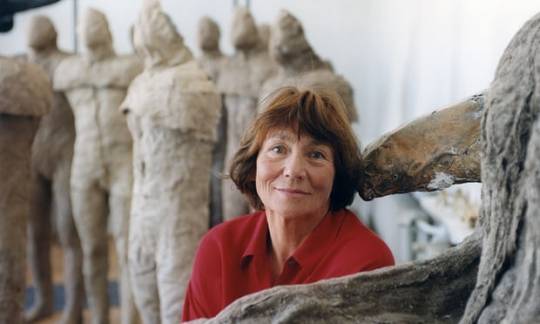
This polish sculptor was born in Falenty (Warsaw) in 1930.
Her artworks work around various concepts; about the “countless” by attending to quantity and making unrepeatable objects that compound a crowd.
These concepts have to do not only with the unique character of nature but with the dignity and courage inherent to a human being.
In this line, she used poor materials as organic fabrics, ropes, sisals, etc as she had to live in the communist period, as a consequence of Second Worldwide War and she became a master on soft sculptures.

[Embryology, 1978 - 1980, Magdalena Abakanowicz and her artwork, Biennale di Venezia, 1980.]
In this article, we are making two highlights on her work: Abakans and Embryology Series.

[ Abakan Red, 1969. Sisal Weaving on the metal support. 300 x 300 x 100 cm. Collection of Museum Bellerive, Zurich]
Abakans are soft touchable sculptures made with rough fabric. This large size artworks offer an interiority feeling, and as I see them, they are like female reproductive organ which provide with warm, deep and secure shelter feelings.

[circle orange, 1971, sisal weaving 72 inches, Lebreton Gallery]

[Bown Abakans 1969-1972. Sisal weaving 300 x 300 x 350 cm, collection of the artist]
Embryology series (1978 - 1980) is another of the highlighted artworks. It consists of a group of 800 potato-shaped soft sculptures that vary in size and from between each other and some of them spill their innards through the sack in which they are covered with.


[Embryology, 1978 - 1980, Magdalena Abakanowicz, collection of Tate Modern]
4 notes
·
View notes
Text
Naturally Pittsburgh: Big Rivers and Steep Wooded Slopes
by Patrick McShea
Pittsburghers are accustomed to seeing their hometown visually portrayed with its river-hemmed Downtown as a focal point. If your goal is to understand how the city’s geographical position in the greater landscape of southwestern Pennsylvania influences its wildlife and plant cover, images from different perspectives are useful.
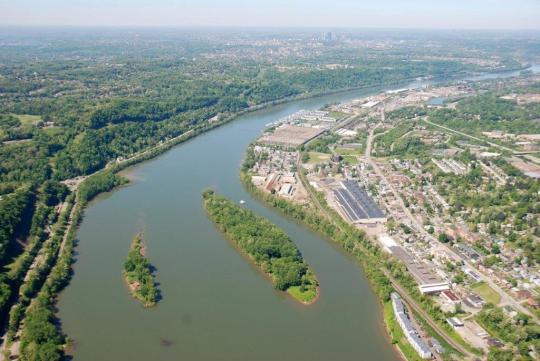
Nine Mile Island, left, and Sycamore Island, right, in the lower Allegheny River. Photo credit: Allegheny Land Trust.
The picture above offers a bird’s eye view down the Allegheny River at a point nine miles upstream from the 325-mile-long waterway’s confluence with the Monongahela River. That much-photographed merge point, which creates the Ohio River, can be spatially located in the frame’s right-of-center background by the hazy blur of Downtown’s tallest buildings. The eye movement required to locate the spot involves tracing steep left-bank wooded bluffs from suburban Penn Hills and along the Pittsburgh neighborhoods of Lincoln-Lemington, Highland Park, and Morningside.
This simple exercise has relevance to the upcoming City Nature Challenge (CNC) for the visual attention it brings to the paired Pittsburgh physical features that keep nature in continual view here - our river system and the steep wooded hillsides carved by these big winding waterways and their tributaries.
Corridors Support Biodiversity
Both features create habitat corridors that serve to enrich the city’s biodiversity. The pair of Bald Eagles with a long record of nesting success on a wooded Monongahela River hillside in Pittsburgh’s Hays neighborhood are the most prominent evidence of this phenomena. Some of the fish they feed their young at this time of year can be regarded as additional evidence.

Pittsburgh fish displayed in tank set-up by the Ohio River Valley Water Sanitation Commission.
Many of the organisms supported by Pittsburgh’s wooded and flowing water corridors do not, however, lend themselves to the photo-documentation of the CNC. Some notable tree specimens and spring wildflower stands are found on high inaccessible ledges, river visits by diverse forms of waterfowl occur more frequently in the winter rather than the spring, and the predictability of the dozens fish species found in Pittsburgh’s waters challenges even the anglers who pursue them.
Importance of Incomplete Survey
The solution to this dilemma, as you record CNC observations and interpret the collective results, is simply to regard this important citizen science initiative as necessarily incomplete. In a recent BioScience paper co-authored by Nicole Heller, Curator of Anthropocene Studies at CMNH, analysis of urban biodiversity studies from all over the world pointed to the importance of enhancing public engagement and environmental stewardship. That is something that can certainly happen this year between April 30 and May 3, in a City Nature Challenge that recognizes some unavoidable bio-survey gaps.
Patrick McShea works in the Education and Visitor Experience department of Carnegie Museum of Natural History. Museum employees are encouraged to blog about their unique experiences and knowledge gained from working at the museum.
Citations for research paper:
“The Biological Deserts Fallacy: Cities in Their Landscapes Contribute More than We Think to Regional Biodiversity,” BioScience, Volume 71, Issue 2, February 2021, Pages 148–160,
Erica N Spotswood, Erin E Beller, Robin Grossinger, J Letitia Grenier, Nicole E Heller, Myla F J Aronson, The Biological Deserts Fallacy: Cities in Their Landscapes Contribute More than We Think to Regional Biodiversity, BioScience, Volume 71, Issue 2, February 2021, Pages 148–160, https://doi.org/10.1093/biosci/biaa155
#Carnegie Museum of Natural History#City Nature Challenge#Pittsburgh#Urban nature#City Nature#Nature#Naturalist
36 notes
·
View notes
Photo

i know what i’m about, son
preemptively putting the full playlist under the cut for the one or two curious people who would have otherwise had to ask
edit: i realized that my initial version was bridge from “take out the trash” erasure so that’s also now on the playlist
“Answer”
“I Love You For Psychological Reasons”
“When Will You Die?”
“Marty Beller Mask”
“Good to Be Alive”
“Mrs. Bluebeard”
“Experimental Film”
“Stone Cold Coup D’etat”
“Aaa”
“Bangs”
“The Mesopotamians”
“All Time What”
“Underwater Woman”
“Can’t Keep Johnny Down”
“Museum of Idiots”
“Hovering Sombrero”
“Erase”
“Authenticity Trip”
“To a Forest”
“Lost My Mind”
“Contrecoup”
“End of the Rope”
“Money for Dope”
“Icky”
“This Microphone”
“All the Lazy Boyfriends”
“Take Out the Trash”
#incoherent ramblings#they might be giants#what i've learned from making this playlist is that Glean is my favorite for bass lines apparently
1 note
·
View note
Photo
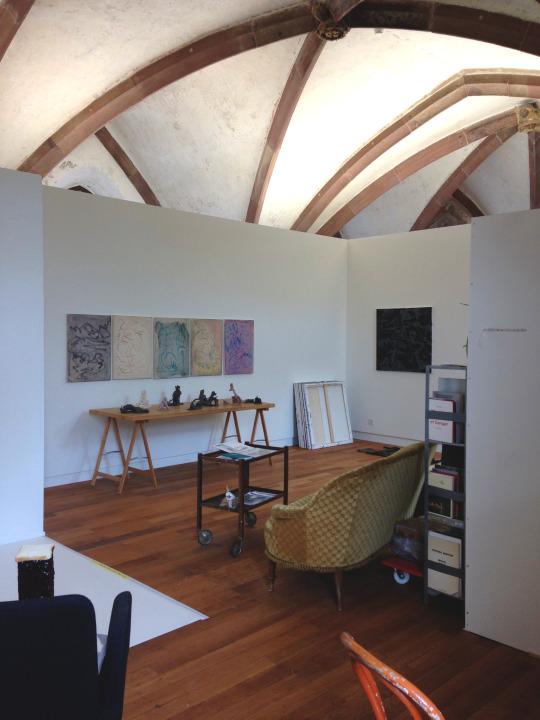

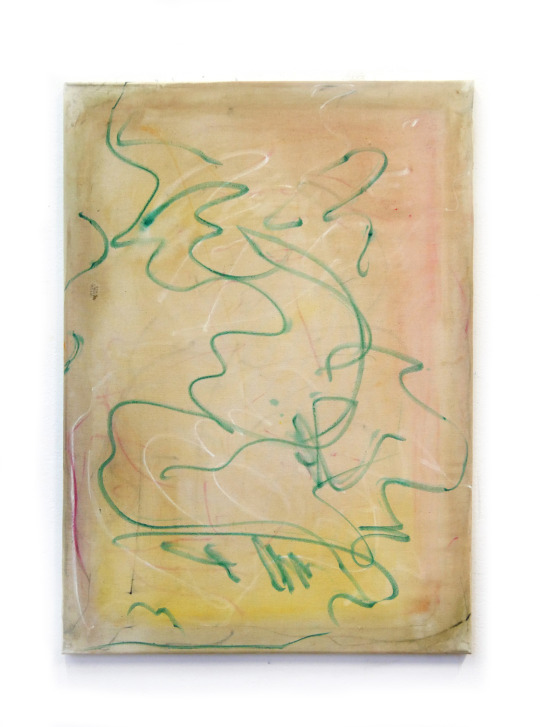

Blick ins Atelier
von Raphael Stucky in Basel
In der Rubrik «Blick ins Atelier» besuchen wir Künstler*innen, die mit dem Museum verbunden sind, virtuell in ihren Ateliers. Es interessiert uns, woran sie gerade arbeiten, was sie beschäftigt und wie sie ihre Arbeit strukturieren.
Raphael Stucky bespielt aktuell den «Dienstraum», unsere Dependance auf Gleis 7 im Bahnhof Olten mit seiner Arbeit «Wind». Kuratorin Katja Herlach hat dem Basler Künstler, Musiker und Kurator ein paar Fragen gestellt und ihn gebeten, uns Einblick in seine Arbeitsstätte und die Entstehung seiner neusten Arbeiten zu geben:
Antworten von Raphael Stucky
1 KH: Was machst du heute?
RS: Gerade bin ich mit dem Zug durch Olten gerauscht. Ich tippe hier auf meinem Ipad und geniesse die vorbeiziehende Landschaft. Schon bald werde ich die Alpen sehen, wo ich mir ein paar Tage Auszeit gönne und im Garten meiner Eltern bei der Ernte helfe.
2 Wie sieht Dein Arbeitsort aus?
Seit September dieses Jahres habe ich eines der 30 Förderateliers der Stadt Basel bezogen. Es ist ein Privileg dort zu sein, da die subventionierten Ateliers sich in der ehemaligen Klingentalkirche befinden. Im obersten Stock spannt sich das Kreuzrippengewölbe über meinen Arbeitsort und ein gotisches Kirchenfenster eröffnet mir den Blick in die Kronen der benachbarten Bäume. Es ist ein einzigartiger Raum, in dem ich meine kommende Zeit verbringen werde.
3 Woran arbeitest Du gerade?
Momentan bereite ich mich für die kommenden zwei Ausstellungen im Dezember vor. Zum einen zeige ich eine Installation im Max Frisch Bad in Zürich. Sie wird auf die unangenehme Vorgeschichte des Ortes Bezug nehmen. Zum anderen arbeite ich an Malereien, Keramikfiguren und Lichtkörpern, die ich in einer Ausstellung im Le Manoir in Martiny zeigen werde.
4 Vor Kurzem hast Du Deine Ausstellung im Dienstraum, unserer Dependance im Bahnhof Olten, eingerichtet. Was interessiert Dich an diesem Raum?
Ich muss sagen, es ist ein sehr schwieriger Ort für Kunstausstellungen. Für mich war es eine Herausforderung in einem so hektischen und reizüberfluteten Ort, wie es der Bahnhof ist, Kunst auszustellen. Es ist das Gegenteil von einem Museum, wo Stille und Raum eine gewünschte Aufmerksamkeit erzeugen.
Diese rauschende Umgebung macht aber auch den Reiz des Raumes aus: Eine Herausforderung, dem Umfeld Stand zu halten. Aber auch zu wissen, dass täglich hunderte Menschen daran vorbei ziehen. Kunst en passant, diese Idee gefällt mir.
5 Im Dienstraum zeigst Du ein Skulpturenpaar aus Keramik. Diese Technik begleitet Dich nun schon eine Weile. Was fasziniert Dich daran?
Das Bedürfnis, Figuren aus Ton herzustellen, entstand während der Zeit, als ich an meiner Master Thesis schrieb. Das Formen mit den Fingern und Händen ermöglichte es mir, einen unmittelbaren und sensorischen Zugang zur Thematik herzustellen. Es war eine gute Ergänzung zum Lesen und Schreiben. Das Arbeiten mit dem Ton erdet, macht den Geist locker und lässt mit den Händen denken. Es ist für mich auch stark mit einer Kindheitserinnerung verknüpft und noch weiter zurück gedacht, ist das Formgeben mit Erde ein urmenschliches Bedürfnis.
6 Handwerk wird in der zeitgenössischen Kunst seit einiger Zeit – gerade auch bei jüngeren Kunstschaffenden – wieder öfter thematisiert. Was bedeutet es Dir?
In meiner künstlerischen Arbeit geht es oft um die Hand. Die Hand, die Form gibt, die Spuren hinterlässt, die mit Instrumenten musiziert und die Bewegung hervorruft. Handwerk bedeutet für mich, eine Tätigkeit mit Händen zu vollziehen. Ich begebe mich gerne in solch entschleunigende Prozesse, die dem Tempo und dem Leistungsdruck unserer Gesellschaft entgegenwirken. Ich denke auch nicht, dass das Handwerk je verschwinden wird. Denn das Taktile und Sensitive sind und bleiben ein Bestandteil in der Kunst. Die Konzeptkunst und die Digitalisierung haben uns neue Formen und Herangehensweisen gebracht, die sich weitgehend von dem traditionellen Handwerk gelöst haben. Ich verstehe aber nicht, wieso man diese Dinge gegeneinander ausspielen muss. In der Kunst hat das alles Platz und ich finde es schön zu sehen, wie der Kunstbegriff kontinuierlich aufgefächert und erweitert wird.
7 Die Beschäftigung mit Klang und Musik ist eine wichtige Konstante Deines Schaffens. Wie schaffst Du die Verbindung zur Form, zum künstlerischen Kontext?
Für mich sind die Trennlinien der Begriffe Kunst, Klang, Musik, aber auch Bewegung und Tanz sehr unscharf. Denn sie sind alle verwandt und seit jeher Teil menschlichen Ausdrucks. Es ist ein zivilisatorisches Konstrukt, dass wir die Disziplinen trennen und eigens dafür Museen, Theater oder Konzertsäle bauen. Ich interessiere mich für die Synästhesie, also die Verknüpfungen und Zusammenkunft verschiedener Sinneswahrnehmungen. Wie klingt ein Bild, was sehe ich, wenn ich zuhöre, welche Bilder kommen, wenn ich einen Geruch wahrnehme? Unsere Sinneswahrnehmung ist komplex und daher finde ich ihre klar definierten Trennungen problematisch.
Zurück zur Frage: mich faszinieren Musik, Klänge und Töne, da sie nicht fassbar sind. Sie kommen, lassen unseren Körper für eine kurze Zeit vibrieren und verschwinden wieder.
In unserer Gesellschaft und vor allem auch in der Kunst ist das Auge das dominante Sinnesorgan. Durch die Beschäftigung mit Klang offenbaren sich neue Zugänge zur Welt und die angesprochene Hierarchie des Visuellen wird dadurch hinterfrage. Das finde ich als Künstler sehr inspirierend. Bei meinen Skulpturen oder Zeichnungen liegt der Klang oft in der Assoziation, in der Vorstellung und in der Potentialität. Es sind also „stumme“ Kunstwerke, bei deren Betrachtung eine Erinnerung an ein Geräusch, einen Klang oder ein Musikstück geweckt werden kann. Und auch in der Sprache, was in meinem Fall vor allem die Werktitel anbelangt, suche ich nach einer klanglich reizvollen Formulierung.
8 Welche Rolle spielen Zeit und Improvisation in Deiner Arbei?
In meinen Zeichnungen und Videoloops versuche ich flüchtige Momente fest zu halten. Ein gutes Beispiel dafür sind die Sekundenzeichnungen: Hier sind in schnell getakteten Gesten viele Zeichnungen entstanden. Jede Zeichnung war einzigartig und ein Recording des Moments in dem sie entstand. Mir gefällt die Idee, dass in jeder Sekunde das Potential für eine neue Erfindung steckt.
Andersrum versuche ich in der musikalischen Improvisation flüchtige Momente zu erzeugen. Improvisation heisst aus dem Moment heraus etwas entstehen zu lassen.
Der Berner Schlagzeuger und Klangkünstler Julian Sartorius erzählte mir in einem Interview: «Viele Musiker haben einen grossen Respekt vor der Improvisation, aber eigentlich ist ja das ganze Leben eine Improvisation!»
Mehr über Raphael Stucky erfahren:
Website des Künstlers
Blogbeitrag zu seiner aktuellen Präsentation im Dienstraum Olten

Raphael Stucky: Wind, 2019, Ausstellungsansicht Dienstraum, Bahnhof Olten, 2020; Foto: Raphael Stucky
Abbildungen:
Abb. 1
Ateliersituation, 2020
Atelierhaus Klingental, Basel
Foto: Raphael Stucky
Abb. 2
Raphael Stucky
«Tell A Bee», 2020
Steinzeug und Spray
Ausstellungsansicht Gartenausstellung «Hortus», Zürich
Foto: Simon Javed Baumberger
Abb. 3
Raphael Stucky
«Untitled», 2019
Wachsstift auf Leinwand
Foto: Raphael Stucky
Abb. 4
Musikalische Improvisation von Raphael Stucky und Angi Nend, 2020
Bellerive Museum, Zu��rich
Foto: Stefan Burger
Veröffentlicht von Katja Herlach am 6.10.2020
0 notes